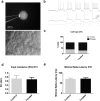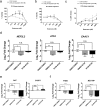Toxicity, recovery, and resilience in a 3D dopaminergic neuronal in vitro model exposed to rotenone
- PMID: 29955902
- PMCID: PMC6063347
- DOI: 10.1007/s00204-018-2250-8
Toxicity, recovery, and resilience in a 3D dopaminergic neuronal in vitro model exposed to rotenone
Abstract
To date, most in vitro toxicity testing has focused on acute effects of compounds at high concentrations. This testing strategy does not reflect real-life exposures, which might contribute to long-term disease outcome. We used a 3D-human dopaminergic in vitro LUHMES cell line model to determine whether effects of short-term rotenone exposure (100 nM, 24 h) are permanent or reversible. A decrease in complex I activity, ATP, mitochondrial diameter, and neurite outgrowth were observed acutely. After compound removal, complex I activity was still inhibited; however, ATP levels were increased, cells were electrically active and aggregates restored neurite outgrowth integrity and mitochondrial morphology. We identified significant transcriptomic changes after 24 h which were not present 7 days after wash-out. Our results suggest that testing short-term exposures in vitro may capture many acute effects which cells can overcome, missing adaptive processes, and long-term mechanisms. In addition, to study cellular resilience, cells were re-exposed to rotenone after wash-out and recovery period. Pre-exposed cells maintained higher metabolic activity than controls and presented a different expression pattern in genes previously shown to be altered by rotenone. NEF2L2, ATF4, and EAAC1 were downregulated upon single hit on day 14, but unchanged in pre-exposed aggregates. DAT and CASP3 were only altered after re-exposure to rotenone, while TYMS and MLF1IP were downregulated in both single-exposed and pre-exposed aggregates. In summary, our study shows that a human cell-based 3D model can be used to assess cellular adaptation, resilience, and long-term mechanisms relevant to neurodegenerative research.
Keywords: 3D LUHMES; Cellular defence; Gene response; Neurodegeneration; Pesticide; Recovery; Resilience; Rotenone.
Conflict of interest statement
Conflict of interest
The authors declare that they have no conflict of interest.
Research involving human participants and/or animals
This article does not contain any clinical studies with human participants or animals performed by any of the authors.
Figures








Similar articles
-
A LUHMES 3D dopaminergic neuronal model for neurotoxicity testing allowing long-term exposure and cellular resilience analysis.Arch Toxicol. 2016 Nov;90(11):2725-2743. doi: 10.1007/s00204-015-1637-z. Epub 2015 Dec 8. Arch Toxicol. 2016. PMID: 26647301 Free PMC article.
-
Human iPSCs derived astrocytes rescue rotenone-induced mitochondrial dysfunction and dopaminergic neurodegeneration in vitro by donating functional mitochondria.Transl Neurodegener. 2020 Apr 24;9(1):13. doi: 10.1186/s40035-020-00190-6. Transl Neurodegener. 2020. PMID: 32345341 Free PMC article.
-
Rotenone exerts developmental neurotoxicity in a human brain spheroid model.Toxicol Appl Pharmacol. 2018 Sep 1;354:101-114. doi: 10.1016/j.taap.2018.02.003. Epub 2018 Feb 8. Toxicol Appl Pharmacol. 2018. PMID: 29428530 Free PMC article.
-
Mitochondrial complex I inhibitor rotenone-induced toxicity and its potential mechanisms in Parkinson's disease models.Crit Rev Toxicol. 2012 Aug;42(7):613-32. doi: 10.3109/10408444.2012.680431. Epub 2012 May 11. Crit Rev Toxicol. 2012. PMID: 22574684 Review.
-
Neurotoxicity of the pesticide rotenone on neuronal polarization: a mechanistic approach.Neural Regen Res. 2019 May;14(5):762-766. doi: 10.4103/1673-5374.249847. Neural Regen Res. 2019. PMID: 30688258 Free PMC article. Review.
Cited by
-
Drug treatment alters performance in a neural microphysiological system of information processing.Commun Biol. 2025 Jun 17;8(1):916. doi: 10.1038/s42003-025-08194-6. Commun Biol. 2025. PMID: 40527961 Free PMC article.
-
Integrated Microphysiological Systems: Transferable Organ Models and Recirculating Flow.Adv Biosyst. 2019 May;3(5):e1900018. doi: 10.1002/adbi.201900018. Epub 2019 Apr 1. Adv Biosyst. 2019. PMID: 32627410 Free PMC article. Review.
-
A Novel Analog of the Natural Product Fraxinellone Protects against Endogenous and Exogenous Neurotoxicants.ACS Chem Neurosci. 2024 Jul 17;15(14):2612-2622. doi: 10.1021/acschemneuro.4c00090. Epub 2024 Jun 26. ACS Chem Neurosci. 2024. PMID: 38925635 Free PMC article.
-
Exploring the Effect of Rotenone-A Known Inducer of Parkinson's Disease-On Mitochondrial Dynamics in Dictyostelium discoideum.Cells. 2018 Nov 8;7(11):201. doi: 10.3390/cells7110201. Cells. 2018. PMID: 30413037 Free PMC article.
-
Enhanced differentiation of human dopaminergic neuronal cell model for preclinical translational research in Parkinson's disease.Biochim Biophys Acta Mol Basis Dis. 2020 Apr 1;1866(4):165533. doi: 10.1016/j.bbadis.2019.165533. Epub 2019 Aug 20. Biochim Biophys Acta Mol Basis Dis. 2020. PMID: 31442530 Free PMC article.
References
-
- Bal-Price A, Crofton KM, Sachana M, Shafer TJ, Behl M, Forsby A, Hargreaves A, Landesmann B, Lein PJ, Louisse J, Monnet-Tschudi F, Paini A, Rolaki A, Schrattenholz A, Suñol C, van Thriel C, Whelan M, Fritsche E. Putative adverse outcome pathways relevant to neurotoxicity. Crit Rev Toxicol. 2015;45(1):83–91. doi: 10.3109/10408444.2014.981331. - DOI - PMC - PubMed
-
- Bal-Price A, Leist M, Schildknecht S, Tschudi-Monnet F, Paini A, Terron A (2017b) Inhibition of the mitochondrial complex I of nigro-striatal neurons leads to parkinsonian motor deficits. https://aopwiki.org/aops/3. Accessed 25 Feb 2018
MeSH terms
Substances
LinkOut - more resources
Full Text Sources
Other Literature Sources
Molecular Biology Databases
Research Materials

